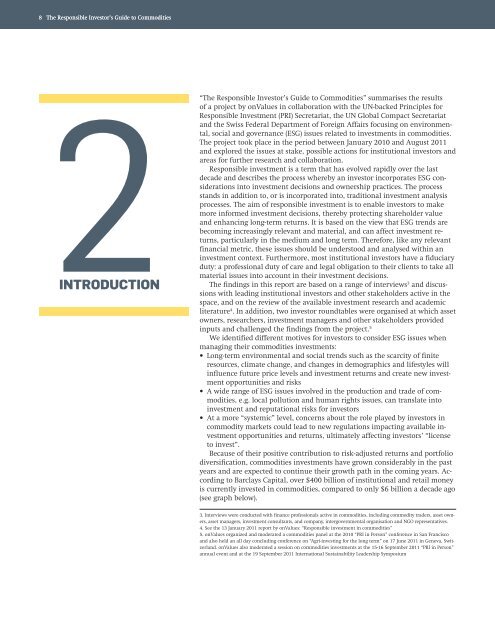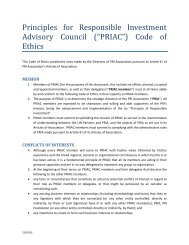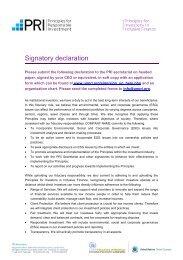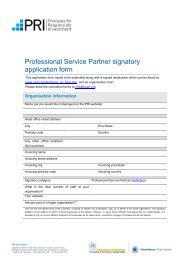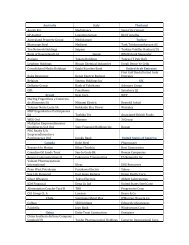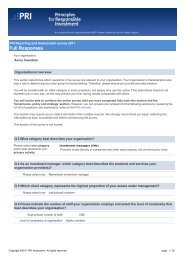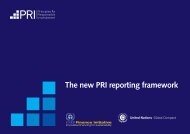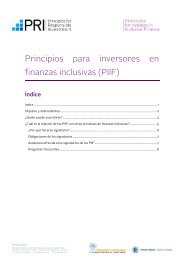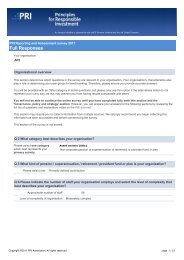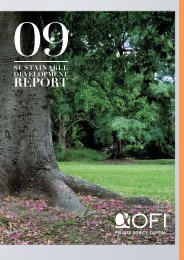investor's guide to commodities - PRI Signatory Extranet - Principles ...
investor's guide to commodities - PRI Signatory Extranet - Principles ...
investor's guide to commodities - PRI Signatory Extranet - Principles ...
- No tags were found...
Create successful ePaper yourself
Turn your PDF publications into a flip-book with our unique Google optimized e-Paper software.
8 The Responsible Inves<strong>to</strong>r’s Guide <strong>to</strong> Commodities2INTRODUCTION“The Responsible Inves<strong>to</strong>r’s Guide <strong>to</strong> Commodities” summarises the resultsof a project by onValues in collaboration with the UN-backed <strong>Principles</strong> forResponsible Investment (<strong>PRI</strong>) Secretariat, the UN Global Compact Secretariatand the Swiss Federal Department of Foreign Affairs focusing on environmental,social and governance (ESG) issues related <strong>to</strong> investments in <strong>commodities</strong>.The project <strong>to</strong>ok place in the period between January 2010 and August 2011and explored the issues at stake, possible actions for institutional inves<strong>to</strong>rs andareas for further research and collaboration.Responsible investment is a term that has evolved rapidly over the lastdecade and describes the process whereby an inves<strong>to</strong>r incorporates ESG considerationsin<strong>to</strong> investment decisions and ownership practices. The processstands in addition <strong>to</strong>, or is incorporated in<strong>to</strong>, traditional investment analysisprocesses. The aim of responsible investment is <strong>to</strong> enable inves<strong>to</strong>rs <strong>to</strong> makemore informed investment decisions, thereby protecting shareholder valueand enhancing long-term returns. It is based on the view that ESG trends arebecoming increasingly relevant and material, and can affect investment returns,particularly in the medium and long term. Therefore, like any relevantfinancial metric, these issues should be unders<strong>to</strong>od and analysed within aninvestment context. Furthermore, most institutional inves<strong>to</strong>rs have a fiduciaryduty: a professional duty of care and legal obligation <strong>to</strong> their clients <strong>to</strong> take allmaterial issues in<strong>to</strong> account in their investment decisions.The findings in this report are based on a range of interviews 3 and discussionswith leading institutional inves<strong>to</strong>rs and other stakeholders active in thespace, and on the review of the available investment research and academicliterature 4 . In addition, two inves<strong>to</strong>r roundtables were organised at which asse<strong>to</strong>wners, researchers, investment managers and other stakeholders providedinputs and challenged the findings from the project. 5We identified different motives for inves<strong>to</strong>rs <strong>to</strong> consider ESG issues whenmanaging their <strong>commodities</strong> investments:• Long-term environmental and social trends such as the scarcity of finiteresources, climate change, and changes in demographics and lifestyles willinfluence future price levels and investment returns and create new investmen<strong>to</strong>pportunities and risks• A wide range of ESG issues involved in the production and trade of <strong>commodities</strong>,e.g. local pollution and human rights issues, can translate in<strong>to</strong>investment and reputational risks for inves<strong>to</strong>rs• At a more “systemic” level, concerns about the role played by inves<strong>to</strong>rs incommodity markets could lead <strong>to</strong> new regulations impacting available investmen<strong>to</strong>pportunities and returns, ultimately affecting inves<strong>to</strong>rs’ “license<strong>to</strong> invest”.Because of their positive contribution <strong>to</strong> risk-adjusted returns and portfoliodiversification, <strong>commodities</strong> investments have grown considerably in the pastyears and are expected <strong>to</strong> continue their growth path in the coming years. According<strong>to</strong> Barclays Capital, over $400 billion of institutional and retail moneyis currently invested in <strong>commodities</strong>, compared <strong>to</strong> only $6 billion a decade ago(see graph below).3. Interviews were conducted with finance professionals active in <strong>commodities</strong>, including commodity traders, asset owners,asset managers, investment consultants, and company, intergovernmental organisation and NGO representatives.4. See the 13 January 2011 report by onValues: “Responsible investment in <strong>commodities</strong>”5. onValues organized and moderated a <strong>commodities</strong> panel at the 2010 “<strong>PRI</strong> in Person” conference in San Franciscoand also held an all day concluding conference on “Agri-investing for the long term” on 17 June 2011 in Geneva, Switzerland.onValues also moderated a session on <strong>commodities</strong> investments at the 15-16 September 2011 “<strong>PRI</strong> in Person”annual event and at the 19 September 2011 International Sustainability Leadership Symposium


